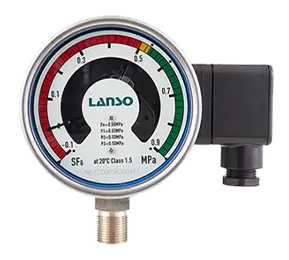SF6, as a commonly used insulating medium in electrical equipment, has attracted wide attention due to its excellent insulation performance and reliable operational characteristics. However, in the complex environment of GIS equipment, SF6 may face issues such as arc-induced metal vapor release, reducing its stability and exhibiting corrosive characteristics, which pose hidden risks to insulation components. For the power industry, ensuring the stability of SF6, timely detection of problems, and identifying unstable states during operation have become important issues of current concern.
SF6 Online Gas Density Monitoring: Technology Principles and Development Status
SF6 Characteristics Analysis
SF6 itself is a colorless, odorless, non-toxic, non-combustible inert compound with a stable covalent structure, making it an important medium in the insulation field. In the environment of GIS, due to the high temperature effects of arcs, SF6 may decompose to produce substances like SO2, SOF2, SO2F2, which need to be analyzed to determine the severity of discharge.
SF6 Online Gas Density Monitoring Technology
Traditional methods of SF6 gas detection include pressure gauge measurement, density relay measurement, semiconductor measurements, but they have some issues. In recent years, with the advancement of advanced sensor technology and microelectronics technology, SF6 online gas density monitoring technology has been continuously improved.
Pressure Gauge Measurement
Measures the pressure of GIS SF6 gas, but its application is limited in environments with large temperature variations.
Density Relay Measurement
Mechanical properties result in poor seismic resistance, making it difficult to accurately determine minor leaks.
Semiconductor Sensors
Utilize tin dioxide semiconductors as electrodes, providing high accuracy but relatively limited lifespan.
Ultrasonic Velocity Measurement
Detects SF6 leaks by changes in the speed of ultrasonic waves, stable but costly.
Current Development Trends
With the advancement of advanced sensor technology and microelectronics technology, SF6 online gas density monitoring technology shows a trend towards online, continuous, and automated development. Main directions include spectroscopic absorption detection based on Lambert-Beer law and infrared detection principles, as well as attention to temperature and humidity. Laser detection, oxygen sensors combined with SF6 sensors, infrared detection, etc., have become major technological development directions.
Promoting the Advancement of SF6 Online Gas Density Monitoring Technology
Current technological trends indicate that, driven by sensor technology and communication technology, SF6 online gas density monitoring will increasingly move towards online, continuous, and automated systems. Laser detection technology, with its advantages of low false alarm rate and long lifespan, has become an important development direction, while the combination of oxygen sensors and SF6 sensors forming a dual gas probe, achieve high-precision measurement of SF6 through laser, infrared, and other means. Infrared detection technology, based on gas absorption in specific wavelengths, is one of the important working methods of SF6 online gas density monitoring.
Taking into account factors such as gas temperature, humidity, pressure, and decomposition substances, SF6 online gas density monitoring technology has become the mainstream in the power industry, providing strong support for ensuring safe equipment operation. In the future, with continuous technological innovation, SF6 online gas density monitoring technology will see broader applications and higher levels of development.







